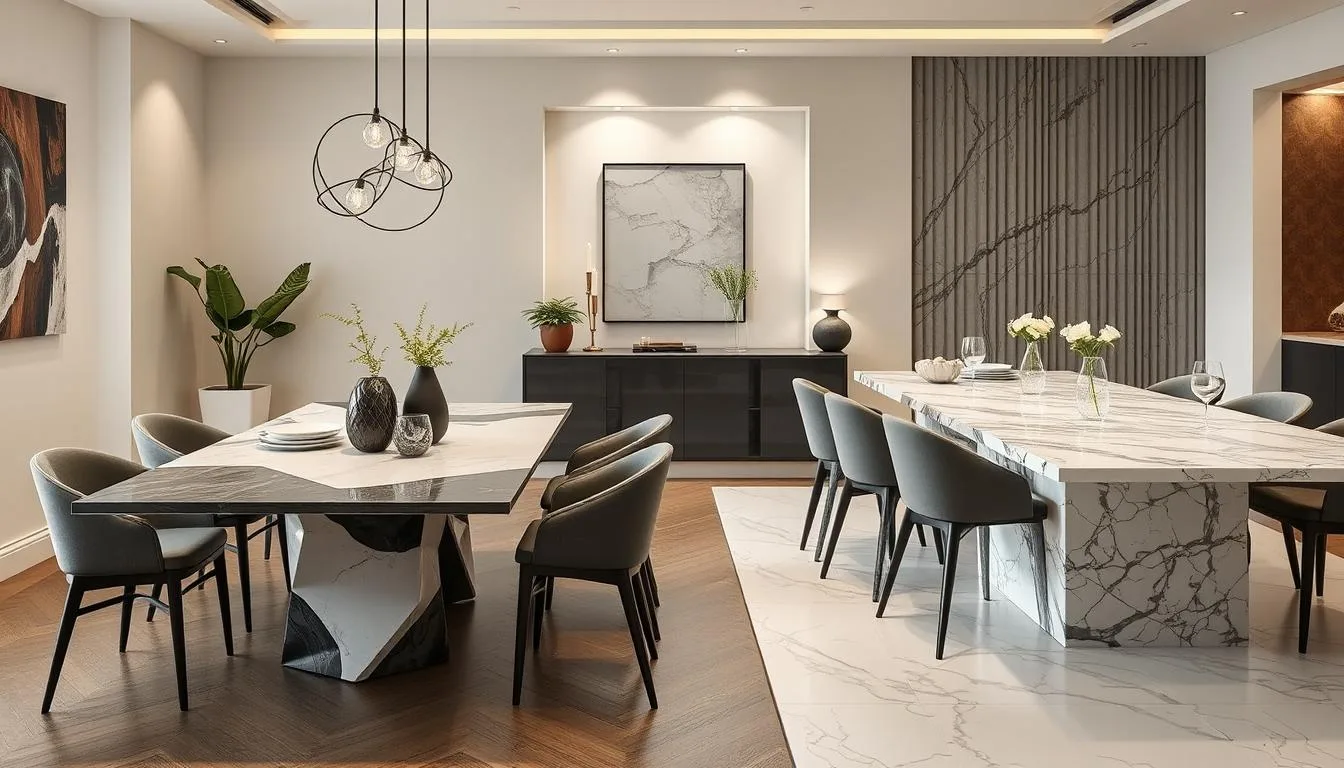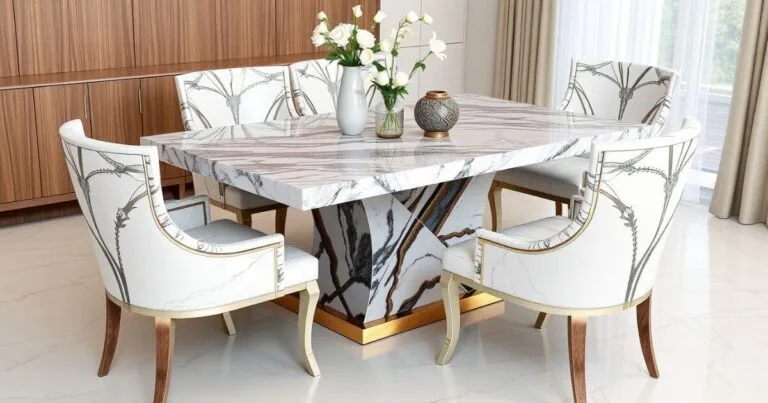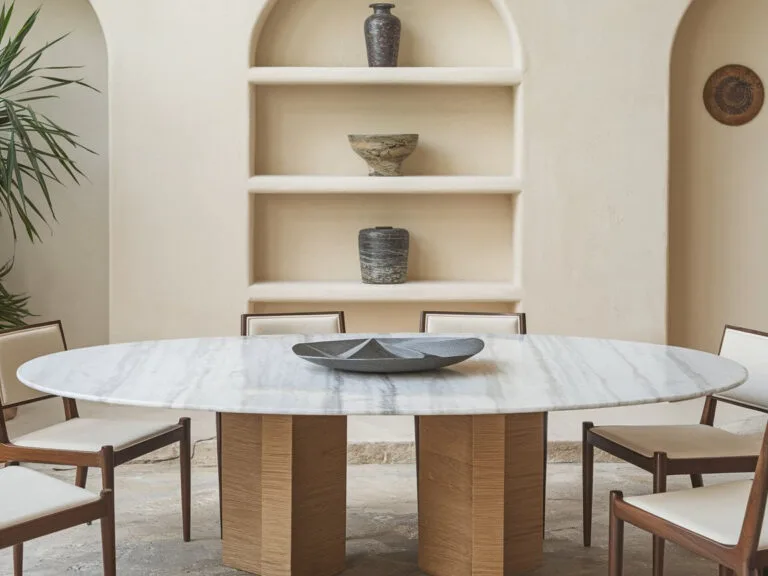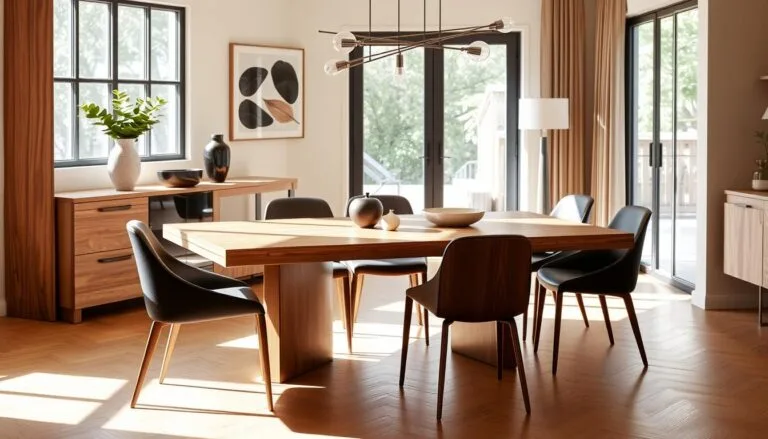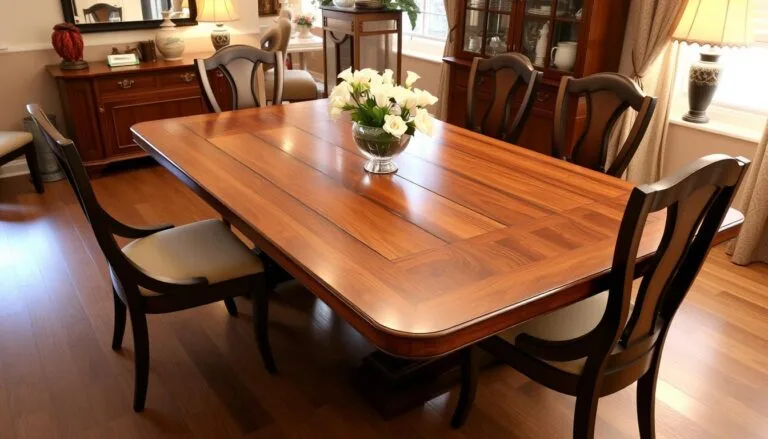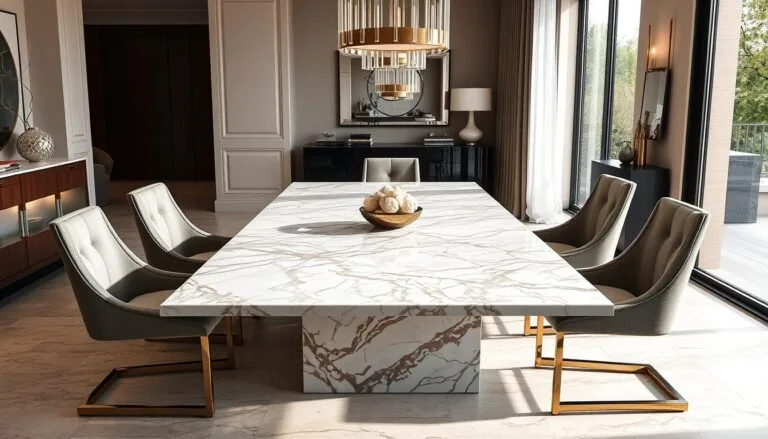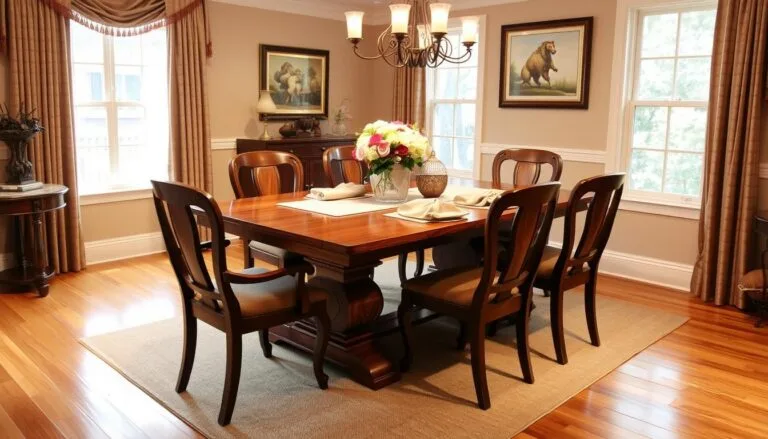Ceramic Dining Table vs Marble: Which Is Better?
The dining room table is a key piece in your home. It’s where special meals and gatherings happen. Choosing the right table is a big decision.
It should be timeless, durable, and beautiful. It must fit well with your home’s design. When looking for a new table, knowing your options is crucial.
Ceramic and marble are two popular choices. Understanding their differences is important for your home and lifestyle.
Table of Contents
Introduction to Dining Table Materials
Choosing the right dining table is key for your home. The material affects durability, upkeep, and looks. Ceramic and marble are top picks, each with its own perks and downsides. Knowing the differences helps you pick the best for your home and taste.
Importance of Choosing the Perfect Dining Table
Your dining table is the heart of your dining room. It must look good and last long. The material decides how well it handles scratches, stains, and heat, and how easy it is to clean.
Overview of Ceramic and Marble as Popular Options
Ceramic tables are known for being tough, great for families or busy homes. They mix porcelain stoneware with tempered glass for a durable, easy-to-clean surface. Marble, a natural stone, brings a classic look with unique patterns and veining.
“Choosing the right dining table material can make a significant difference in the durability, maintenance, and overall aesthetic of your dining space.”
Understanding Ceramic Dining Tables
Ceramic and marble are top picks for dining tables. Let’s look into ceramic tables. We’ll cover their makeup, how they’re made, and their benefits.
Composition and Manufacturing Process
Ceramic tables are made from clay, water, and heat. The clay is molded and fired at high temperatures. This makes the table strong and resistant to scratches, stains, heat, and cuts.
Durability and Versatility of Ceramic
Ceramic tables are very durable. They are lightweight, perfect for moving around for different events. Their sealed surface also means they’re easy to keep clean, needing little upkeep.
These tables come in many designs. You can find them in modern, traditional, and more styles. They’re available in various colors, shapes, and patterns to match your home.
“Ceramic table surfaces can be as thin as ¼ inch, providing a sleek and modern aesthetic to the dining area.”
Marble tables, on the other hand, are heavy. They’re less easy to move around. Marble is known for its beauty but needs more care to avoid stains and scratches.
In the ceramic vs. marble debate, ceramic tables stand out. They’re durable, versatile, and easy to design with. Their low-maintenance and heat-resistant qualities make them a great choice for today’s dining rooms.
Exploring Marble Dining Tables
Marble has been loved for centuries for its beauty and elegance. It’s made from limestone that’s been changed by the earth over millions of years. Each marble slab is unique, with patterns that show the earth’s history.
Natural Formation and Unique Patterns
Marble’s look is special because of how it’s formed. When limestone is heated and pressed deep in the earth, it turns into marble. This process creates a material that’s both strong and beautiful.
The marble surface can be many colors, from white to gray, with unique patterns. These patterns are like fingerprints, making each marble slab different.
Elegance and Luxury of Marble
Marble dining tables are known for their luxury and style. Their glossy finish and durability make them perfect for any home. Ceramic vs marble tabletop choices have different looks, but marble stands out for its elegance.
Marble also keeps your dining area cool, which is great for warm places or homes without air conditioning. Whether you choose a classic white or a bold gray-veined marble, it will make your dining area special.
“Nothing can quite compare to a marble table top, and every marble table has its own unique look.”
ceramic dining table vs marble: Key Differences
Choosing a dining table material is a big decision. Ceramic and marble have their own benefits. Knowing the differences can help you pick the right one for your dining room.
Appearance and Design Options
Ceramic tables are made from clay and other materials. They look like marble but are more even. Marble, on the other hand, is natural and has unique patterns and colors.
Maintenance and Cleaning Requirements
Ceramic tables are easy to keep clean. A damp cloth can wipe them down. Marble tables need more care to stay looking good. They must be dusted and cleaned often to avoid stains.
Heat and Stain Resistance
Both ceramic and marble tables are tough. But ceramic is better at handling sharp cuts and heat. Marble can stain easily, so it needs more upkeep.
| Feature | Ceramic Dining Table | Marble Dining Table |
|---|---|---|
| Appearance | Consistent and predictable | Unique and varied patterns |
| Maintenance | Low-maintenance, easy to clean | Requires more attention and cleaning |
| Heat and Stain Resistance | Highly resistant to heat and stains | Durable but more susceptible to stains and damage |
Choosing between ceramic and marble tables depends on your style and needs. Think about what you want your dining room to look like.
Factors to Consider When Choosing
Choosing the right dining table for your home involves more than looks. Think about the table’s weight, how easy it is to move, and the cost. These factors can help you decide between a ceramic or marble table.
Weight and Mobility
The weight of the table is key. Marble is dense and heavy, making it hard to move or change your dining area. Ceramic tables are lighter, making them easier to move and adjust.
If you often change your dining table’s location or plan to move, a ceramic table is better. Some ceramic tables can grow or shrink, fitting your needs as they change.
Cost and Budget Implications
Cost is another big factor. Marble tables cost more because of the stone’s quality and rarity. Ceramic tables are cheaper, fitting tighter budgets.
Marble tables might cost more upfront. But think about the long-term costs. Ceramic tables need less care and last longer, saving you money over time.
| Feature | Ceramic Dining Tables | Marble Dining Tables |
|---|---|---|
| Weight and Mobility | Lightweight and easier to move | Heavier and more challenging to rearrange |
| Cost and Budget | Generally more affordable | Higher initial investment due to material quality |
| Durability | Highly resistant to scratches, stains, and heat | Durable but prone to scratches and stains |
| Maintenance | Non-porous, easier to clean and maintain | Porous, requiring regular sealing and care |
Think about the table’s weight, mobility, cost, and budget when choosing. This will help you pick the right table for your needs and style.
Integrating with Interior Design Styles
Choosing between a ceramic or marble dining table is easy. Both materials fit well with many interior design styles. It’s all about matching the material’s look with your dining room’s feel.
Ceramic tables come in many colors and finishes. This makes it simple to find one that matches your decor. You can pick from modern to rustic styles. Some ceramic tables even grow to fit up to 12 chairs, perfect for big gatherings.
Marble tables, however, bring a classic and luxurious vibe. Their natural patterns add interest and elegance to your room. Marble works well with both traditional and modern designs.
So, whether you pick a ceramic or marble dining table, choose one that fits your style. By picking the right material, your dining area will look great and show off your taste.
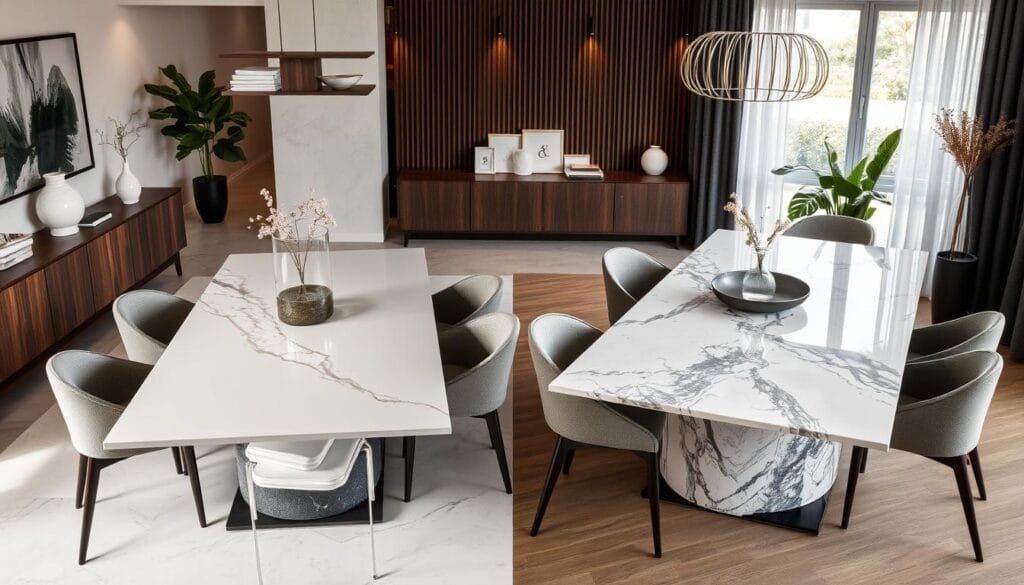
“The beauty of a dining table lies not only in its functionality but also in its ability to elevate the overall aesthetic of the space.”
Pros and Cons: A Comprehensive Analysis
Choosing between a ceramic and a marble dining table involves looking at both sides. Each option has its own set of benefits and drawbacks. Knowing these can help you pick the right table for your home.
Advantages of Ceramic Dining Tables
- Unparalleled durability: Ceramic dining tables can last for centuries, showing their lasting quality.
- Stain and scratch resistance: Their non-porous surface makes them easy to keep clean and resistant to damage.
- Heat and temperature resilience: Ceramic tables can handle very high temperatures, making them safe for hot dishes.
- Easy maintenance: Cleaning them is simple with a microfiber cloth and mild detergent, keeping them looking new.
- Design versatility: Ceramic tables come in many colors and patterns, fitting any style from modern to classic.
Drawbacks of Ceramic Dining Tables
Despite their many benefits, ceramic tables have some downsides:
- Uniform appearance: Ceramic’s consistent look might not offer the same visual appeal as marble’s unique patterns.
- Potential for chipping: Ceramic can chip or crack if hit hard or if heavy objects are placed on it.
- Cost considerations: While cheaper than marble, ceramic tables can still vary in price based on design and features.
Choosing between ceramic and marble depends on your taste, budget, and home needs. Weighing the pros and cons helps you find a table that’s both functional and beautiful.
| Feature | Ceramic Dining Tables | Marble Dining Tables |
|---|---|---|
| Durability | Highly durable, can withstand centuries of use | Durable but can be prone to chipping or cracking |
| Stain and Scratch Resistance | Virtually stain-free and highly scratch-resistant | Susceptible to staining and scratching |
| Heat Resistance | Extremely heat-resistant, can handle temperatures up to 2,000°C | Less heat-resistant, can be prone to cracking or discoloration |
| Maintenance | Easy to clean, requiring only a microfiber cloth and mild detergent | Requires more specialized cleaning and care to prevent damage |
| Design Versatility | Offers a wide range of color and pattern options | Unique natural patterns, but limited in color options |
| Cost | Generally more affordable than marble | Typically more expensive than ceramic |
ceramic dining table vs marble: The Final Verdict
The debate between ceramic and marble dining tables has been ongoing. Each material has its own benefits, depending on your taste, lifestyle, and design goals. Let’s explore the key factors to consider.
Ceramic dining tables are durable and easy to maintain. They fit well with many design styles. Ceramic can handle heat, cuts, and stains, perfect for busy homes. Marble tables, on the other hand, add luxury and timeless beauty to any room.
Ceramic tables are lighter, making them easier to move and adjust. Marble is heavier, which might be a problem if you like to change your dining area often.
Ceramic tables are also more affordable than marble ones. Yet, both materials are durable and last long, making them good investments.
Choosing between a ceramic dining table or a marble dining table depends on your style, maintenance habits, and budget. Think about the pros and cons of each to find the best fit for your dining space.
“The right dining table can transform a space, elevating both the aesthetic and the functionality of your home.”
Whether you choose ceramic for its durability or marble for its elegance, your decision reflects your personal style. It will add a unique touch to your dining room.
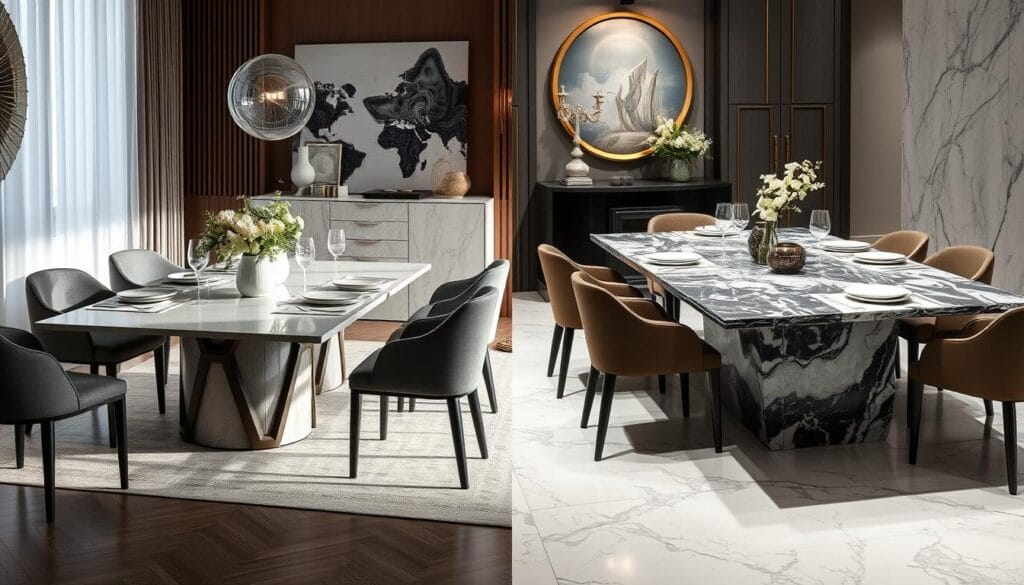
Conclusion
Choosing a dining table material is a big decision. Both ceramic and marble have their own perks. Ceramic tables are durable, versatile, and easy to clean. They’re great for modern homes.
Marble tables, however, bring timeless elegance and natural beauty. They can make your dining room look amazing.
So, should you choose ceramic or marble? It depends on what you like, how you live, and what you want your dining room to look like. Think about looks, upkeep, weight, and cost to make the best choice.
Whether you pick ceramic for its modern feel or marble for its luxury, your table will be the heart of your dining room. It will be the spot where memories are made.
In the end, both ceramic and marble have their own benefits. The right choice depends on your needs and taste. By looking at the pros and cons, you can find the perfect table for your home.

